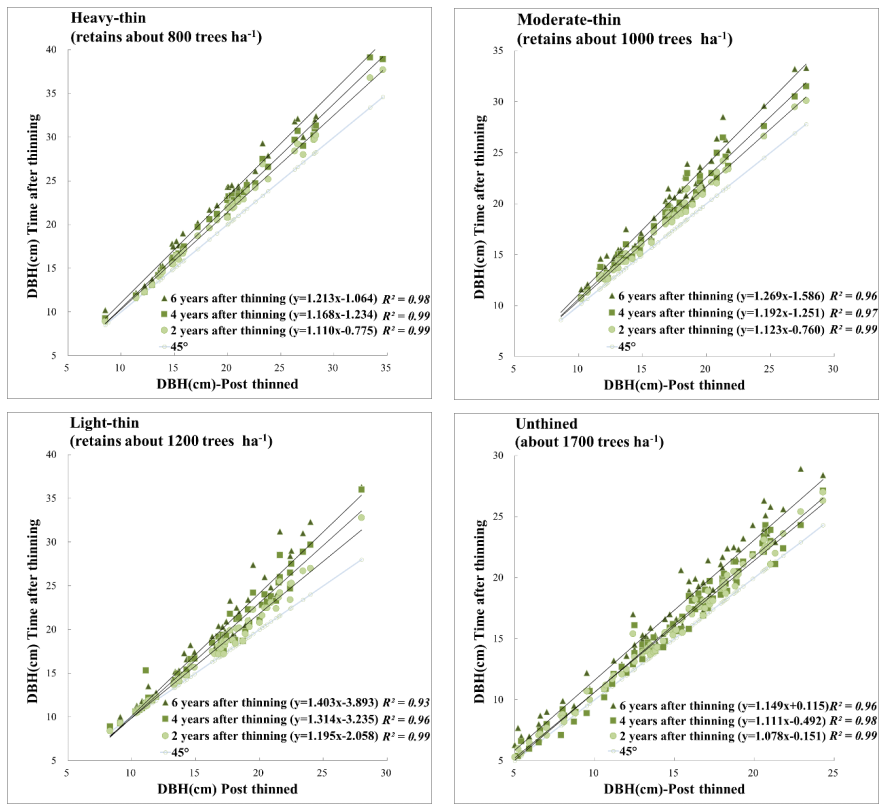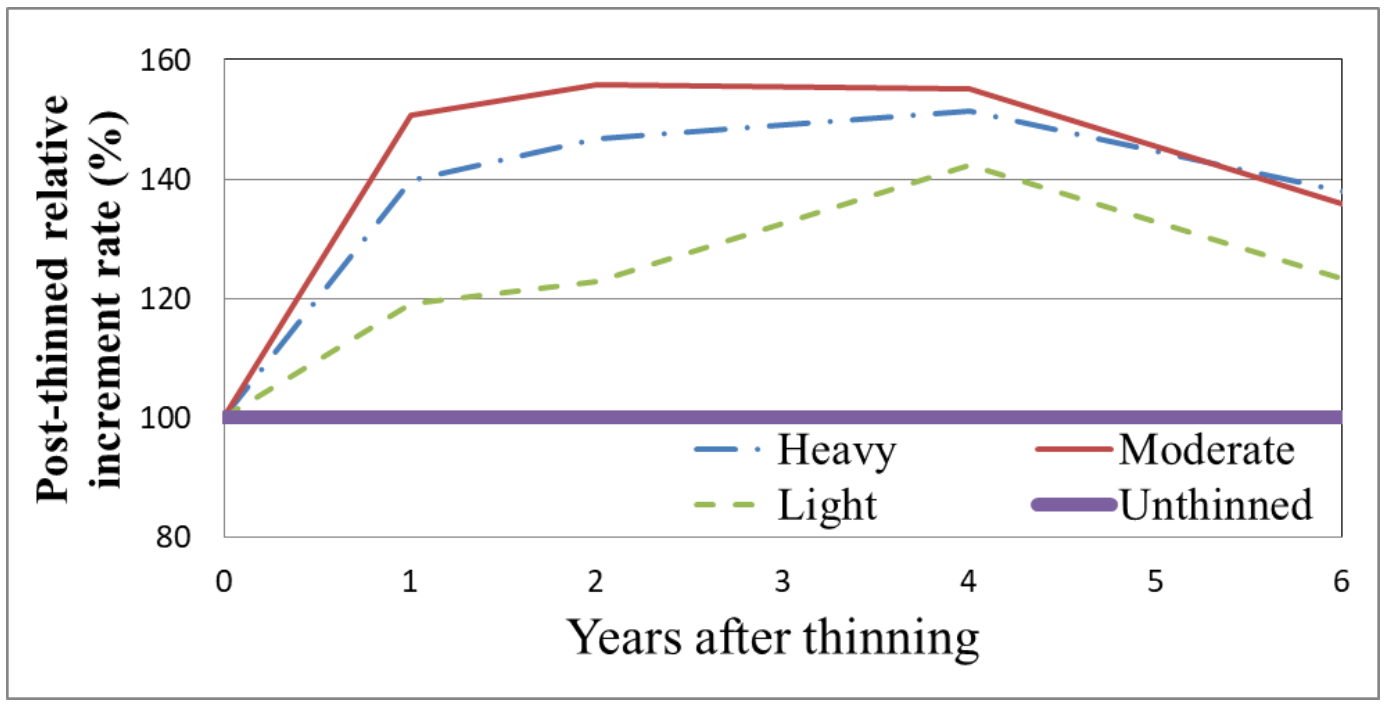Effects of Thinning on the Growth and Relative Change in the Diameter of a Mahogany Plantation
Abstract
:1. Introduction
2. Study Area, Materials, and Methods
2.1. Study Area
2.2. Data Collection
2.3. Data Analysis
3. Results and Discussion
3.1. Effect of Thinning on the Growth and Relative Change of Single Wood DBH
3.2. Effects of Thinning on Stand Structures
3.3. Effects of Thinning on Average DBH among Individual Growth Periods
4. Conclusions and Suggestions
Author Contributions
Funding
Institutional Review Board Statement
Informed Consent Statement
Data Availability Statement
Acknowledgments
Conflicts of Interest
References
- Huang, S.S. Studies on the Chemical Constituents and Anti-Inflammatory Activities from the Fruit of Swietenia Macrophylla. Master’s Thesis, School of Department of Pharmacy and Master Program, Tajen University, Pingtung, Taiwan, 2009; 133p. (In Chinese). [Google Scholar]
- Chuang, Y.S. Inhibition of Hepatitis C Virus Replication Extracted from Swietenia Macrophylla King. Master’s Thesis, School of Kaohsiung Medical University Graduate Institute of Natural Products, Kaohsiung, Taiwan, 2010; 94p. (In Chinese). [Google Scholar]
- Wang, S.Y. Commercial Timber (Expanded Edition); The Chinese Forest Products Association: Taipei, Taiwan, 2002; 377p. (In Chinese) [Google Scholar]
- Feng, F.L. Establishing the Monitor System of Plantation Sustainable Management—A Case Study of Thinning Effect in Swietenia Macrophylla Plantation; Dongshih Forest District Office: Taichung, Taiwan, 2008; 66p. (In Chinese) [Google Scholar]
- Roberts, S.D.; Harrington, C.A. Individual tree growth response to variable-density thinning in coastal Pacific Northwest forests. For. Ecol. Manag. 2008, 255, 2771–2781. [Google Scholar] [CrossRef]
- Cañellas, I.; Rio, M.D.; Roig, S.; Montero, G. Growth response to thinning in Quercus pyrenaica Willd. Coppice stands in Spanish central mountain. Ann. For. Sci. 2004, 61, 243–250. [Google Scholar] [CrossRef] [Green Version]
- Lee, J.S. A Monitoring Plan for Thinning Contrast Zone; No 94-03-05-03; Dongshih Forest District Office: Taichung, Taiwan, 2005; 45p. (In Chinese) [Google Scholar]
- Juodvalkis, A.; Kairiukstis, L.; Vasiliauskas, R. Effects of thinning on growth of six tree species in north-temperate forests of Lithuania. Eur. J. For. Res. 2005, 124, 187–192. [Google Scholar] [CrossRef]
- Lee, J.S. Studies on the thinning of Taiwan red cypress plantation. Technical bulletin of department of forestry. Nat. Chung-Hsing Univ. 1985, 202, 50. (In Chinese) [Google Scholar]
- Lee, J.S.; Yen, T.M.; Jong, S.S.; Chiang, J.M.; Lo, Y.S. Studies on stand density control of Chamaecyparis formosensis plantation-The basic analysis for thinning stands. Bull. Expt. For. NCHU 1997, 19, 101–111. (In Chinese) [Google Scholar]
- Yang, Y.C.; Chen, C.M.; Lin, W.L. Commercial thinning of cryptomeria plantation. Bull. Exp. For. Nat. Taiwan Univ. 1976, 118, 39–94. (In Chinese) [Google Scholar]
- Lo-Cho, C.N.; Chung, H.H.; Chiu, C.M.; Chou, C.F.; Lo, S.S. Effects of thinning and pruning on Taiwania (Taiwania crypto-merioides Hayata) plantation. Bull. Taiwan For. Res. Inst. New 1991, 6, 155–168. (In Chinese) [Google Scholar]
- Chiu, C.M.; Tang, S.L.; Lin, C.J. Effects of thinning on growth and wood properties of Taiwania (Taiwania cryptomerioides) and Taiwan red cypress (Chamaecyparis formosana) plantations. TFRI Ext. Ser. 2007, 179, 160–189. (In Chinese). [Google Scholar]
- Chiu, C.M.; Tang, S.L.; Suen, M.Y.; Peng, P.H. Effects of thinning strategies on the carbon sequestration of Taiwania (Taiwania cryptomerioides) plantations. Q. J. Chin. For. 2018, 51, 21–36. (In Chinese) [Google Scholar]
- Kim, M.; Lee, W.K.; Kim, Y.S.; Lim, C.H.; Song, C.; Park, T.; Son, Y.; Son, Y.M. Impact of thinning intensity on the diameter and height growth of Larix kaempferi stands in central Korea. For. Sci. Technol. 2016, 12, 77–87. [Google Scholar]
- Nishizono, T. Effects of thinning level and site productivity on age-related changes in stand volume growth can be explained by a single rescaled growth curve. For. Ecol. Manag. 2010, 259, 2276–2291. [Google Scholar] [CrossRef]
- Zeide, B. Thinning and growth: A full turnaround. J. For. 2001, 99, 20–25. [Google Scholar]
- Coomes, D.A. Challenges to the generality of WBE theory. Trends Ecol. Evol. 2006, 21, 593–596. [Google Scholar] [CrossRef] [PubMed]
- Reich, P.B.; Tjoelker, M.G.; Machado, J.L.; Oleksyn, J. Universal scaling of respiratory metabolism, size and nitrogen in plants. Nature 2006, 439, 457–461. [Google Scholar] [CrossRef] [PubMed]
- Nyland, R.D. Silviculture: Concepts and Applications, 2nd ed.; McGraw-Hill: Boston, MI, USA, 2002; 682p. [Google Scholar]
- Coomes, D.A.; Allen, R.B. Effects of size, competition and altitude on tree growth. J. Ecol. 2007, 95, 1084–1097. [Google Scholar] [CrossRef]
- Bailey, R.L.; Dell, T.R. Quantifying diameter distributions with the Weibull function. For. Sci. 1973, 19, 97–104. [Google Scholar]
- Frazier, J.R. Compatible Whole-Stand and Diameter Distribution Models for Loblolly Pine Plantations. Ph.D. Dissertation, Virginia Polytechnic Institute and State University, Lackburg, VA, USA, 1981; 125p. [Google Scholar]
- Law, A.M.; Kelton, W.D. Simulation Modeling and Analysis, 3rd ed.; McGraw-Hill: New York, NY, USA, 2000; 760p. [Google Scholar]
- Smalley, G.W.; Bailey, R.L. Yield Tables and Stand Structure for Shortleaf Pine Plantations in Tennessee, Alabama, and Georgia Highlands; U.S. Department of Agriculture, Forest Service, Southern Forest Experiment Station: New Orleans, LA, USA, 1974; 57p.
- Arrospide, E.; Bikandi, I.; García, I.; Durana, G.; Aldabaldetreku, G.; Zubia, J. “7-Mechanical Properties of Polymer-Optical Fibres” in Polymer Optical Fibres, 1st ed.; Woodhead: Sawston, UK, 2017; 436p. [Google Scholar]
- Lee, J.S.; Chen, C.T. Study on the thinning of Taiwan red cypress of young plantation in Tahsueh Shan-Influence of thinning on diameter distribution. Q. J. Chin. For. 1985, 18, 19–28. (In Chinese) [Google Scholar]
- Chang, J.Y. Thinning Effect on the Stand Structure Development and Regeneration of Swietenia macrophylla Plantation. Master’s Thesis, School of Department of Forestry, National Chung Hsing University, Taichung, Taiwan, 2008; 84p. (In Chinese). [Google Scholar]
- Chen, C.T.; Chen, J.C. Forest Management; Cheng Chung Book Co.: Taipei, Taiwan, 2015; 417p. (In Chinese) [Google Scholar]
- Peng, P.H.; Pan, H.L.; Tang, S.L.; Chiu, C.M.; Chiang, H.L.; Chen, J.C. Effect of thinning on the diameter increment growth of Taiwan cedar. Q. J. Chin. For. 2019, 52, 205–222. (In Chinese) [Google Scholar]
- Zhan, Y.X. Using Terrestrial Laser Scanning System to Monitor Thinning Effects for Taiwania cryptomerioides Hayata Plantation. Master’s Thesis, School of Department of Forestry, National Pingtung University of Science and Technology, Pingtung, Taiwan, 2019; 96p. (In Chinese). [Google Scholar]
- Cheng, K.T. The Species Composition and Stand Structure of Secondary Forest in Tajen Experimental Forest Station. Master’s Thesis, School of Department of Forestry, National Pingtung University of Science and Technology, Pingtung, Taiwan, 2017; 92p. (In Chinese). [Google Scholar]
- Yen, T.M. The System of Growth and Yield for Chamaecyparis formosensis Plantations in Ta-Hsueh-Shen Area of Taiwan. Ph.D. Thesis, School of Department of Forestry, National Chung Hsing University, Taichung, Taiwan, 1997; 178p. (In Chinese). [Google Scholar]
- Mäkinen, H.; Isomäki, A. Thinning intensity and long-term changes in increment and stem form of Norway spruce trees. For. Ecol. Manag. 2004, 201, 295–309. [Google Scholar] [CrossRef]





| Thinning Intensity | Tree Density (Trees ha−1) | Pre-Thinning | Post-Thinning | Years after Thinning | |||
|---|---|---|---|---|---|---|---|
| 1 | 2 | 4 | 6 | ||||
| Heavy | 800 | 17.1 ± 6.8 | 19.6 ± 6.3 | 20.9 ± 6.5 | 21.5 ± 6.8 | 22.2 ± 7.2 | 23.4 ± 7.5 |
| Moderate | 1000 | 14.5 ± 4.6 | 16.4 ± 4.3 | 17.5 ± 4.3 | 18.1 ± 4.5 | 18.7 ± 4.8 | 19.7 ± 5.2 |
| Light | 1200 | 15.3 ± 4.9 | 16.7 ± 4.3 | 17.4 ± 4.8 | 17.9 ± 5.2 | 18.7 ± 5.8 | 19.6 ± 6.2 |
| Un-thinned | 1700 | 14.3 ± 5.2 | 14.3 ± 5.2 | 14.9 ± 5.4 | 15.2 ± 5.6 | 15.8 ± 5.7 | 16.9 ± 6.5 |
| Weibull | K-S Test | |||||
|---|---|---|---|---|---|---|
| Time | Thinning Intensity Class | a | b | c | Dn | D0.05 |
| Pre-thinned | Heavy | 4.9 | 13.55 | 1.9 | 0.095 ns | 0.220 |
| Moderate | 6.0 | 9.68 | 2.4 | 0.089 ns | 0.175 | |
| Light | 4.0 | 12.89 | 2.32 | 0.090 ns | 0.185 | |
| Un-thinned | 2.7 | 13.54 | 2.51 | 0.071 ns | 0.178 | |
| Post-thinned | Heavy | 8.5 | 12.30 | 1.72 | 0.106 ns | 0.264 |
| Moderate | 7.1 | 10.66 | 2.35 | 0.082 ns | 0.226 | |
| Light | 8.3 | 9.92 | 1.96 | 0.102 ns | 0.214 | |
| Un-thinned | 2.7 | 13.54 | 2.51 | 0.071 ns | 0.178 | |
| One year after thinning | Heavy | 8.7 | 13.57 | 1.87 | 0.107 ns | 0.272 |
| Moderate | 10.5 | 7.90 | 1.59 | 0.098 ns | 0.231 | |
| Light | 8.4 | 10.39 | 1.88 | 0.085 ns | 0.214 | |
| Un-thinned | 3.1 | 13.80 | 2.43 | 0.074 ns | 0.178 | |
| Two years after thinning | Heavy | 8.9 | 13.99 | 1.83 | 0.108 ns | 0.272 |
| Moderate | 10.7 | 8.34 | 1.55 | 0.104 ns | 0.231 | |
| Light | 8.4 | 10.87 | 1.83 | 0.078 ns | 0.214 | |
| Un-thinned | 3.2 | 14.05 | 2.36 | 0.073 ns | 0.178 | |
| Four years after thinning | Heavy | 9.3 | 14.37 | 1.77 | 0.108 ns | 0.272 |
| Moderate | 10.8 | 8.96 | 1.56 | 0.101 ns | 0.231 | |
| Light | 8.9 | 11.14 | 1.71 | 0.085 ns | 0.214 | |
| Un-thinned | 3.4 | 14.37 | 2.35 | 0.066 ns | 0.179 | |
| Six years after thinning | Heavy | 10.2 | 14.73 | 1.76 | 0.133 ns | 0.276 |
| Moderate | 11.6 | 9.05 | 1.49 | 0.110 ns | 0.231 | |
| Light | 8.9 | 12.16 | 1.76 | 0.074 ns | 0.216 | |
| Un-thinned | 4.3 | 14.57 | 2.29 | 0.062 ns | 0.182 | |
| Years after Thinning | ||||
|---|---|---|---|---|
| Thinning Intensity Class | 1 | 2 | 4 | 6 |
| Heavy | 0.85 ± 0.6 | 0.72 a ± 0.4 | 0.54 a ± 0.3 | 0.54 a ± 0.3 |
| Moderate | 0.92 ± 1.4 | 0.77 a ± 0.8 | 0.55 a ± 0.5 | 0.53 a ± 0.4 |
| Light | 0.73 ± 0.6 | 0.60 ab ± 0.5 | 0.51 a ± 0.5 | 0.48 ab ± 0.4 |
| Un-thinned | 0.61 ± 0.5 | 0.49 b ± 0.3 | 0.36 b ± 0.2 | 0.39 b ± 0.2 |
| F value | 1.82 | 3.47 * | 4.08 ** | 2.81 * |
Publisher’s Note: MDPI stays neutral with regard to jurisdictional claims in published maps and institutional affiliations. |
© 2022 by the authors. Licensee MDPI, Basel, Switzerland. This article is an open access article distributed under the terms and conditions of the Creative Commons Attribution (CC BY) license (https://creativecommons.org/licenses/by/4.0/).
Share and Cite
Peng, P.-H.; Pan, H.-L.; Tang, S.-L.; Chiu, C.-M.; Chiang, H.-L.; Zhan, Y.-X.; Hsieh, Y.-T.; Chen, J.-C. Effects of Thinning on the Growth and Relative Change in the Diameter of a Mahogany Plantation. Forests 2022, 13, 213. https://doi.org/10.3390/f13020213
Peng P-H, Pan H-L, Tang S-L, Chiu C-M, Chiang H-L, Zhan Y-X, Hsieh Y-T, Chen J-C. Effects of Thinning on the Growth and Relative Change in the Diameter of a Mahogany Plantation. Forests. 2022; 13(2):213. https://doi.org/10.3390/f13020213
Chicago/Turabian StylePeng, Ping-Hsun, Hsiao-Lung Pan, Sheng-Lin Tang, Chih-Ming Chiu, Hua-Le Chiang, Yu-Xuan Zhan, Yi-Ta Hsieh, and Jan-Chang Chen. 2022. "Effects of Thinning on the Growth and Relative Change in the Diameter of a Mahogany Plantation" Forests 13, no. 2: 213. https://doi.org/10.3390/f13020213
APA StylePeng, P.-H., Pan, H.-L., Tang, S.-L., Chiu, C.-M., Chiang, H.-L., Zhan, Y.-X., Hsieh, Y.-T., & Chen, J.-C. (2022). Effects of Thinning on the Growth and Relative Change in the Diameter of a Mahogany Plantation. Forests, 13(2), 213. https://doi.org/10.3390/f13020213






